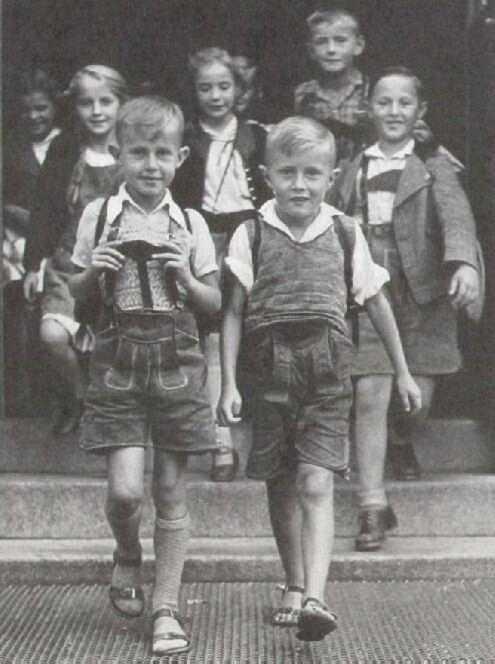
NAZI Education: Level

Figure 1.--A German reader tells us that this school photograph was taken during the NAZI era in the 1930s, but we do not know where it was taken. It looks like it may have been Bavaria. We were surprised to see the German children wearing open-toe sandals in the 1930s.
|
NAZI schools were organized traditionally, as they continued the basic structure of primary and secondary education. We do not yet, however, have much information on the organization of these schools, ages, and policies such as academic selection. The NAZIs maintained the basic structure of German eduacation, but grafted on to it Party schools to train the future generation of leaders. There were special NAZI Party secondary schools for chosen children. There were also post-secondary Party schools. The German educational system from top to bottom was geared to the political requirements of the NAZI regime focusing on inoculating German children and youth with totalitarian, xenophobic, and anti-semetic concepts.
The NAZIs maintained the basic educational structure established in the Weimar Republic. The Reichstag in 1920 passed a law providing for compulsory education of all children between 6 and 14 years of age. Children attended the Grundschule (Foundation School). Advanced primary education was provided by the Volksschule (People's School). The NAZIs did not alter this basic syructure, but used primary schools as a forum for Party propaganda. Instilling young, impressionable minds with NAZI ideology was crucial to ensure acceptance of these principles as adults.
The NAZIs maintained the basic structure of German secondary education inherited from the Weimar Republic. There were three categories of state secondary schools which offered a total of up to 9 years of instruction. The best known was the Gymnasium which offered a classical curriculum. The other two, the Real-Gymnasium and the Oberrealschule, offered a curriculm giving greater emphasis to the sciences and utilitarian courses. The NAZIs while not changing this basic structure, added new schools that were designed to train the future leaders of the Third Reich. Two new types of secondary schools were created.
The first was Nationalpolitische Erziehungsanstalt (NPEA or NAPOLA) schools. The second was the Adolf Hitler Schools. The difference between these two schools is not altogether clear and sems in part to reflect the intermable beureaucratic infighting so prevalent in the Third Reich.
The NAZIs inherited 25 universities from the Weimar Republic, including siome of the most prestigious institutions of higher eduvation in the world. After graduating from secondary schools, qualified German students could attend university. The NAZI introduced a mandatory labor service. University amission required a racial test. Jewish prodessors were almost immediately dismissed and Jewish students soon also excluded from the university. I believe Mischling were generally excluded from secondary schools so had little opportunity to attend university. Students whose parents were involved in pre-1933 political activity oposing the NAZIs might also be excluded unless they redeamed themselves in the Hitler Youth. The NAZI Party also established new elite educational facilities for leadership training.
Christopher Wagner

Related Chronolgy Pages in the Boys' Historical Web Site
[Main Chronology Page]
[The 1910s]
[The 1920s]
[The 1930s]
[The 1940s]
Navigate the German school pages
[Main NAZI education page]
[Main school uniform national page]
[Main German school uniform page]
[Imperial Germany]
[Weimar Republic]
[NAZI era]
[Post-war Years]
[Modern Germany]
Navigate the Relate Boys Historical Clothing Style Pages
[Main country page]
[Long pants suits]
[Short pants suits]
[Lederhosen]
[Kneesocks]
[Eton suits]
[Jacket and trousers]
[Blazer
[School sandals]
Navigate the Boys' Historical Clothing School Uniform Pages
[Main School Uniform Page]
[Australia]
[England]
[France]
[Germany]
[Italy]
[Japan]
[New Zealand]
[Scotland]
[United States]
Navigate the Boys' Historical Clothing Web Page
[Introduction]
[Activities]
[Biographies]
[Chronology]
[Clothing styles]
[Countries]
[Bibliographies]
[Contributions]
[Essays]
[FAQs]
[Glossaries]
[Satellites]
[Tools]
[Boys' Clothing Home]
Created: May 18, 2002
Last updated: July 1, 2002



